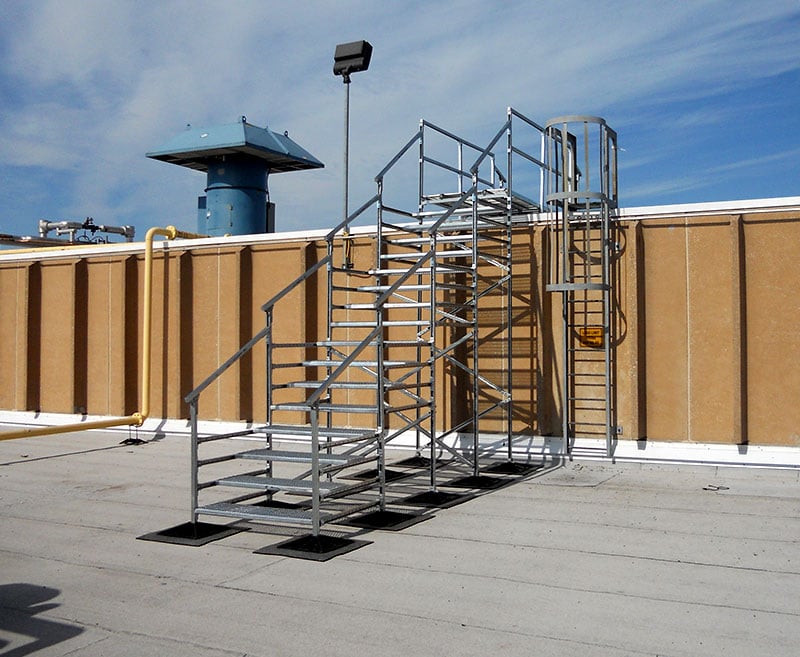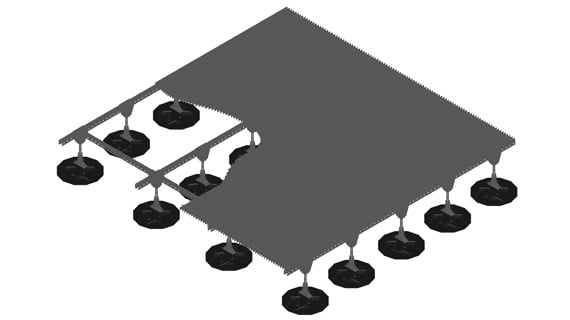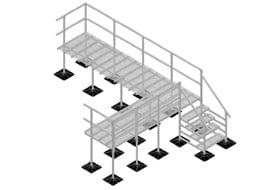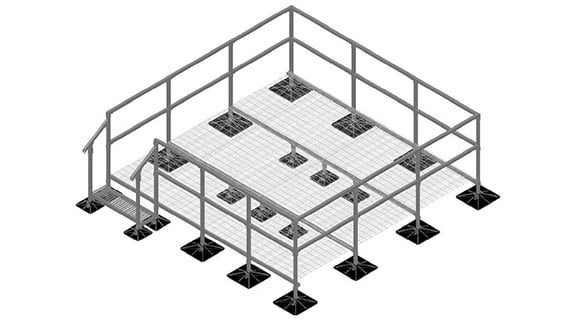Today, many commercial buildings choose to locate their ductwork, cable trays, plumbing, HVAC units, and other large, cumbersome equipment on rooftops. Placing these critical systems in such an isolated area can help protect your important machinery from accidents by untrained professionals, free up valuable interior space, and reduce noise pollution.
However, installing this type of equipment on top of your building can also present a few disadvantages.
Over time, constant foot traffic and dead weight from heavy machines can damage a roof’s protective outer membrane, making it susceptible to problems like water ingress that can threaten your building’s infrastructure. Furthermore, it can be hazardous for building and maintenance professionals to work on these systems at such great heights—especially if they’re relying on unsecured ladders and other temporary structures to reach equipment.
To give workers safe and easy access to rooftop equipment and systems while also preserving the structural integrity of your commercial roof, it’s vital you invest in reliable equipment platforms. However, not all rooftop support systems are beneficial for your building, namely those installed by penetrating the roof.
First, these purpose-built structures help workers access machinery in areas that are otherwise too challenging or dangerous to reach. This way, they can safely handle repairs, conduct routine maintenance, or perform inspections.
Second, they help professionals work more efficiently. While ladders and temporary scaffolding may be adequate for one-time jobs, such as installing new equipment or painting, these measures aren’t sufficient for workers who need regular, indefinite access. A sturdy, permanent, customizable equipment platform allows workers to perform duties on elevated systems in the most ergonomic way possible.
Third, they offer another layer of protection for your rooftop. Platforms can be used to provide extra support for particularly heavy equipment, like HVAC blowers. Unlike cheap wooden blocks or concrete bricks, platforms are built to distribute both human and machinery weight evenly. This helps prevent damage to your roof’s outer membrane, ensuring you get the most out of your roofing investment.
In other words, investing in platforms can help lengthen the lifetime of your roofing.
To identify where you may need platforms, begin by performing an inventory of all your rooftop equipment. Any dead weight currently resting on your roof or areas where workers need regular access can benefit from a secure, custom platform.
When you’re choosing platforms for your roof, there are two things you need to consider: the quality of the product and the experience of the design team. As with most investments you make for your facility, keep in mind that you’ll get what you pay for.
While opting for lower-quality solutions may help you save money today, it will likely cost you a significant amount in the long term—especially if you use a system that penetrates your roof and voids your roofing warranties. Choosing to forego a permanent solution can also lead to working hazards, a higher level of wear and tear on your roof, and more expensive maintenance costs over time.
PHP Systems/Design platforms are constructed with hot-dipped, galvanized steel channel using ¼” steel connectors and steel planking or bar-grated walk surfaces. These systems are supported by high-density polypropylene bases and, because they don’t need to penetrate the roof’s protective membrane, you don’t have to worry about voiding your roof warranty. Our patented zero-penetration design helps evenly distribute weight across your roof’s surface without causing unnecessary damage.
Because no two roofing systems are the same, it’s also crucial you choose a customizable equipment platform system. From the height and width to stair type and weight requirements, PHP Systems/Design can modify and adjust platform products and arrangements to your unique needs.
Our platforms can be installed on any type of roof—from a flat roof up to a slope of 2 to 12 inches. Even with a significant slope, there’s still no need to penetrate the surface membrane. Whether you need a single-access platform or you’re looking to create a full rooftop design from scratch, our team of expert designers will help you build the most efficient and effective setup possible.
Consider inviting an expert to review your rooftop.
Rooftop work is rife with life-threatening hazards. Without adequate support systems, workers risk falling off a roof or falling through weakened areas and skylights. If someone falls onto a rooftop, they risk landing on sharp metal, hot tar, or electrical equipment. With so many perils, it’s no surprise roofing accidents account for more than one-third of all fatalities in the construction industry. When someone falls on or off of a roof, it can have tragic consequences—not to mention the steep fines you’ll have to pay and the damage to your organization’s reputation.
In an effort to curb the number of accidents for those who work above ground level, the Occupational Safety and Health Administration (OSHA) released new guidelines to strengthen worker fall protection in 2017.

These new regulations affect nearly seven million establishments, according to EHS Today. If you haven’t assessed your safety system to ensure compliance with OSHA regulations, you may be in violation. Failing to take necessary precautions to limit workplace hazards not only puts workers at a disadvantage, but it can result in hefty penalties, too.
Providing adequate safety training and investing in a high-quality access platform system will help you meet new regulations and keep your employees safe at any height.
Roof platform systems can be used for a variety of different applications. Here are the three types of platforms PHP Systems/Design offers:
This type of platform provides extra support for heavy rooftop equipment, such as HVAC chillers and blowers.


This type of platform is designed for service areas, smoking areas, and accessing and elevating rooftop media.

PHP Systems/Design equipment access platforms are not only built to provide easy accessibility for workers and extend the lifetime and value of your roof—our products are also made to last. Our easily customizable and ergonomic designs are crafted by experienced professionals to your unique specifications. Best of all, you’ll discover that once they’re installed, galvanized steel platforms require little to no long-term maintenance. With these platforms in place, you can enjoy a lifetime of peace of mind.

PHP Systems/Design
5534 Harvey Wilson Dr.
Houston, TX 77020
Copyright PHP Systems/Design. All rights reserved.